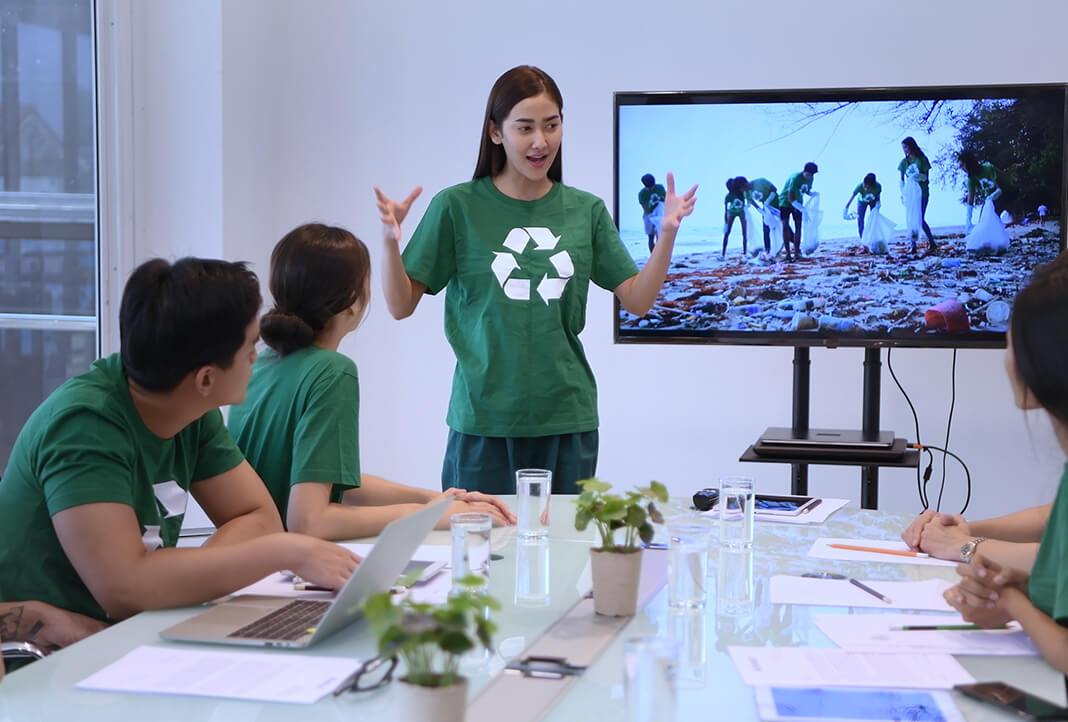Many workers consider environmental sustainability practices when deciding whether to stay, or accept a job with, a company.
According to a Clockwise survey, workers at companies with unsustainable cultures are more than nine times as likely to say they see themselves leaving in the next 12 months.
According to a Gallup poll, about 70 percent of U.S. workers say a company’s environmental record matters to some degree in whether they’d accept a job with the company.
Clearly, environmental sustainability matters to workers, presenting a recruitment and retention opportunity.
“Your environmental sustainability practices may be the advantage you’ve been looking for,” says Amy Freshman, senior director, global HR, ADP. “No matter where you are in your journey, your efforts can be a valuable promotional tool for recruitment and retention. While you shouldn’t hesitate to promote your initiatives, know that environmental sustainability is much bigger than marketing yourself. It’s about impacting the environment. Don’t commit to it solely because it will look good to candidates and employees. Commit to it for the good of the planet. Ensure your initiatives are genuine, ethical and backed by continual action. That’s what matters.”
What is environmental sustainability?
According to the Environmental Protection Agency (EPA), environmental sustainability is based on one principle: Everything we need for survival and well-being depends on our natural environment. Environmental sustainability is about creating and maintaining the conditions under which humans and nature can co-exist productively and harmoniously to support present and future generations. This commitment can extend to the workplace through meaningful environmental action that benefits recruitment and retention.
5 ways environmental sustainability can help you attract and retain talent
1. Improves your company’s reputation
Committing to sustainability shows that you care about the environment, its well-being and the health and well-being of current and prospective employees. If you have strong environmental sustainability practices and promote them well, workers may be more likely to stay, or accept a job with, your company. Consider your efforts and how or whether you market them. Do you include them in your job advertisements or post about them on social media? Have you prepared answers to possible candidate and employee questions? How do you share your commitments internally? Are there plans for monthly, quarterly or annual updates?
2. Fosters employee engagement
Seventy-one percent of workers at sustainable workplaces feel their workplace culture improves how engaged they feel with their work. This makes sense, given the importance some workers place on environmental stewardship and conservation. Moreover, for some workers, sustainability is about more than conserving water and electricity, recycling and other practices. To them, environmental sustainability is existential, equating to healthy, prosperous lives for themselves, their families and future generations. It equates to a version of the planet that maintains their way of life, health outcomes and legacies.
3. Enhances job satisfaction and company brand
According to a report by the National Environmental Education Foundation (NEEF), nearly 90 percent of employees engaged in their company’s sustainability work say it enhances their job satisfaction and overall feelings about the company. Additionally, most respondents either agreed or strongly agreed that their company’s environmental sustainability work enhances the company’s brand in the community. Consider how you can leverage your efforts to reach multiple generations of workers in your industry. Use social media and other channels to amplify your vision and activities. Incorporate your practices into job postings, candidate interviews, recruitment materials, applicant-facing blog posts and newsletters. Find out which job-seeking methods and platforms workers in your industry prefer, and focus your communications there.
4. Inspires a feeling of connection
Implementing employees’ environmental sustainability recommendations may help them feel seen, heard and valued. This feeling is known as “connection.” Research has shown that those who feel strongly connected are less likely to leave. By considering employees’ suggestions and sharing the results, you communicate your willingness to listen and act. You demonstrate that your employees’ concerns are neither invisible nor overlooked. Keep an open mind when they ask about your efforts or suggest improvements. Be sure to recognize their involvement in related initiatives. Did they participate in a project that furthered your environmental sustainability goals? Be sure to acknowledge their contributions. Did their thoughts and ideas come to fruition? Ensure they get the credit. Did they rally other employees? Be sure to thank them for their time. Did they do extra work during or after business hours? Ensure they’re compensated.
5. Entices candidates and employees to participate
Without collective ideas from the broader workforce, companies can’t realize the full potential of their environmental sustainability efforts. Likewise, candidates and employees in your industry and talent market might want to help achieve the maximum potential of your green initiatives. Consider starting a green business resource group (BRG), a group of employees that drive your environmental sustainability goals. The BRG could help your company support sustainable business imperatives and nurture sustainable practices by hosting activities in your community and encouraging participation from community partners and other employees.
“Empower the BRG to partner with your local community to directly impact the environment,” says Dawn Verrinder, senior director, diversity, inclusion and sustainability, ADP. Verrinder is also the environmental, social and governance (ESG) chair of ADP’s Green BRG. “Local chapters of ADP’s Green BRG have embraced environmental volunteer opportunities, including a river clean-up adjacent to one of our offices. This local, personal connection can improve employee engagement and reinforce social responsibility.”
To launch a green BRG, secure leadership buy-in, determine how the BRG can help drive your company’s environmental sustainability goals and continually steer action with meaningful contributions and events. For example, you could celebrate Earth Day (April 22) and Arbor Day (April 28) by planting trees, picking up litter and recyclable material, starting a compost bin, establishing a workplace garden or going paperless. You can also promote the BRG and its activities in recruitment materials, candidate interviews and on social media. And don’t limit yourself to green holidays. Make environmental sustainability a year-round commitment.
Next steps
In addition to supporting environmental stewardship and conservation, environmental sustainability practices may improve your reputation, bottom line, employee engagement, job satisfaction, recruitment and retention. Consider using human capital management (HCM) technology to promote your efforts to current and prospective employees. Otherwise, you’re not maximizing the benefits of your work. Know, however, that environmental sustainability is about more than technology, business strategies and money. It’s about preserving the planet, its resources and your organization — for yourself, your friends and family, your colleagues and the broader community — long after you’ve left your mark.
Learn more about ADP’s environmental commitments
ADP’s Green BRG contributed to this blog post.
ADP’s Green BRG informs smart choices for ADP and its stakeholders by promoting the conservation and restoration of its communities’ natural resources. It supports ADP’s commitment to net-zero greenhouse gas emissions by 2050. Since its launch in 2022, more than 2,000 associates have helped ADP reach its environmental sustainability goals.
National Environmental Education Foundation does not endorse, review or authorize the content stated on this site.
This article originally appeared on SPARK powered by ADP.



